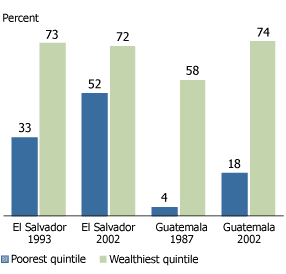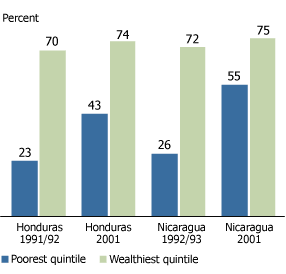
Family Planning Use in Central America: Closing the Equity Gap
(February 2009) Family planning reduces infant and maternal mortality rates by allowing women to plan and space their pregnancies and avoid unintended pregnancies. Pregnancies that are adequately spaced increase child survival by allowing mothers to invest more resources and time in their children. Spaced pregnancies also allow mothers to recover their health and avoid complications, such as anemia, during their next pregnancy. Family planning is also an effective poverty reduction strategy, breaking the link between high fertility and extreme poverty.
The overall contraceptive prevalence among women in union has increased in El Salvador, Guatemala, Honduras, and Nicaragua in the past two decades, according to the latest CDC report, Reproductive, Maternal and Child Health in Central America: Health Equity Trends. With the exception of Guatemala, the gap in contraceptive use between the poorest and wealthiest segments of the population has also decreased. Ensuring equitable access is important in improving maternal and child health, especially among the poor because they are often unaware of the benefits and live in areas where services are unavailable.
Trends in Contraceptive Use
In El Salvador, overall contraceptive use increased from 53 percent in 1993 to 67 percent in 2002 and 2003. During the same period, contraceptive use among the poorest segment of the population increased from 33 percent to 52 percent, while among the wealthiest group, use remained relatively unchanged at 72 percent. As such, the “equity gap” in contraceptive use between the poorest and wealthiest population fell from 40 percent to 20 percent in a decade.
Figure 1
Contraceptive Prevalence Rate by Quintile in El Salvador and Guatemala

Source: Paul W. Stupp, Danni Daniels, and Alicia Ruiz, Reproductive, Maternal and Child Health in Central America: Health Equity Trends (Atlanta: Centers for Disease Control and Prevention, 2007).
Contraceptive use in Guatemala increased overall in the past two decades, from 23 percent in 1987 to 43 percent in 2002. While the equity gap decreased in El Salvador, Honduras, and Nicaragua in the recent past, Guatemala’s gap remained constant at 56 percent. This large gap is due primarily to the concurrent increase of contraceptive use in both the poorest and wealthiest segments of the population.
Surveys conducted in 1991 and 1992 and subsequently in 2001 show an increase of 16 percent in contraceptive use among Honduran women. In the lowest socioeconomic quintile, the contraceptive prevalence increased to 43 percent from 23 percent. Although the inequity in contraceptive use between the poorest and wealthiest Hondurans decreased over time, the gap remained high with a difference of 31 percent in 2001.
Figure 2
Contraceptive Prevalence Rate by Quintile in Honduras and Nicaragua

Source: Paul W. Stupp, Danni Daniels, and Alicia Ruiz, Reproductive, Maternal and Child Health in Central America: Health Equity Trends (Atlanta: Centers for Disease Control and Prevention, 2007).
Among the four countries, Nicaragua has the highest overall contraceptive prevalence with 66 percent. The inequity is small compared to neighboring countries, with 19 percent difference, according to the latest survey conducted in 2001. The narrowing of the gap is attributed to the increase use of contraceptives, especially among the poorest Nicaraguans, where the rate has more than doubled from 24 percent in 1992 and 1993 to 52 percent in 2001. During the same period, contraceptive use among the wealthiest population increased moderately from 65 percent to 71 percent. Therefore, much of the decrease in inequity is due greater access for the poor to family planning services.
Family Planning Advances Closes the Equity Gap
The remarkable improvements in family planning services in Central America are due to a wide array of factors, such as the recognition that family planning plays an important role in ensuring healthy families, increased political support for women’s rights, and the establishment of health facilities in rural areas. In addition, technical and financial support from development agencies such as USAID and UNFPA have helped these countries improve their family planning services and accessibility.
Part of the success in El Salvador is due to the Ministry of Health’s efforts in improving family planning logistics and contraceptive availability at its public health facilities over the past decade. The contraceptive logistics system was redesigned and a cost-effective procurement system was set up to ensure that public health facilities have sufficient quantities of the appropriate contraceptives and that contraceptives are provided to the appropriate service providers. These measures strengthened family planning and helped El Salvador’s family planning program become self-sustainable.
In Guatemala, the Ministry of Health launched an initiative to provide information and access to contraceptives to increase contraceptive awareness among Guatemalans and overcome cultural, religious, and political barriers. Given that contraceptive use was especially low among Mayan women, these efforts focused especially on reaching underserved populations in the Guatemalan highlands. Recent policy efforts in Guatemala have also led to additional funding for reproductive health programs, as well as the approval of a law to provide universal access to family planning.
Efforts in Honduras have also contributed to increasing contraceptive use and closing the equity gap. In the late 1990s, the Honduran government allowed auxiliary nurses from the Secretariat of Health (SOH) to insert Intrauterine Devices, which expanded access to an underused family planning method. In addition, an increase in public coverage by the SOH from 35 percent in 1996 to 41 percent in 2001 improved contraceptive access, particularly among women in the lowest wealth quintile since they rely heavily on public health services.
Legal and political support for reproductive health is strong in Nicaragua, where the constitutional guarantee to reproductive rights ensures contraceptive security. As a result, family planning services are offered by multiple government agencies and private sector organizations, thereby increasing contraceptive access and availability. In addition, the Nicaraguan Ministry of Health uses the community-based contraceptive distribution strategy to target the underserved population.
Family planning improvements made over the past two decades by Central American countries have enabled the poorest segments of the population greater access to contraceptives and family planning services. Further efforts in strengthening existing programs would help ensure contraceptive security and further close the equity gap.
Calvin Siow is an intern with International Programs at PRB.
References
- DELIVER, El Salvador: Securing Essential Contraceptive Supplies for All Who Need Them (Arlington, VA: USAID, 2006).
- DELIVER, Honduras: Moving Contraceptive Security Forward with Political Commitment and Financial Capital (Arlington, VA: USAID, 2006).
- Health Policy Initiative, Safeguarding contraceptive security in Latin America and the Caribbean (Washington, DC: USAID, 2008).
- Paul W. Stupp, Danni Daniels, and Alicia Ruiz, Reproductive, Maternal, and Child Health in Central America: Health Equity Trends (Atlanta: Centers for Disease Control and Prevention, 2007).
- P.A. Taylor, Nicaragua: Contraceptive Security Assessment (Arlington, VA and Washington, DC: USAID, 2004).
- USAID, Telling Our Story Guatemala: Can Family Planning Change Society?, accessed online at www.usaid.gov/stories/guatemala/cs_gt_spacing.pdf, on Feb. 5, 2009.
